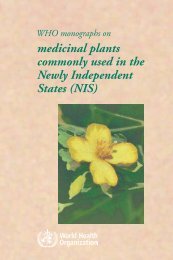Drug-Resistant Malaria - libdoc.who.int - World Health Organization
Drug-Resistant Malaria - libdoc.who.int - World Health Organization
Drug-Resistant Malaria - libdoc.who.int - World Health Organization
Create successful ePaper yourself
Turn your PDF publications into a flip-book with our unique Google optimized e-Paper software.
REVIEW I 21<br />
are signs to suggest this or1g1n. Resistance in Papua New Guinea<br />
is clearly caused by importation from Irian Jaya, the subsequent<br />
spread <strong>int</strong>o the Solomon Islands by importation from Papua New<br />
Guinea, and the spread <strong>int</strong>o Vanuatu originated obviously from<br />
either Papua New Guinea or the Solomon Islands.<br />
It may be noted that resistance to 4-aminoquinolines occurred<br />
in several countries of the Region originally as a resistance to<br />
amodiaquine rather than to chloroquine. The reported difference<br />
in the response to these drugs appears to have, therefore, litt le<br />
practical significance insofar as the Western Pacific Region 1S<br />
concerned.<br />
The continued massive use of 4-aminoquinolines for presumptive<br />
treatment, clinical cure or mass drug distribution has<br />
undoubtedly contributed to the rapid dissemination of resistance<br />
once a resistant strain has been <strong>int</strong>roduced. While due caution<br />
regarding the projec t ion of results in rodent malaria to human<br />
malaria is required, it appears that chloroquine resistance is of<br />
a very stable nature. Genet ic studies carried out in Edinburgh<br />
and epidemiological data on P.falciparum seem to indicate that<br />
resistant mutants have a distinct biological advantage over<br />
sensitive parasites. The former are stable and also overgrow the<br />
latter. This seems to be borne out by the epidemiological<br />
observations in the Western Pacific Region and it would indeed be<br />
useful to carry out observations in an isolated confined area<br />
(island) with established chloroquine resistance and see whether<br />
and when the parasite would revert to a sensitive state upon the<br />
withdrawal of all 4-aminoquinolines.<br />
There are indications from<br />
that a continuous high degree of<br />
importance than drug pressure<br />
resistance.<br />
several countries in<br />
transmission has been<br />
for the ultimate<br />
the Region<br />
of greater<br />
spread of<br />
Other specific questions which need to be answered in<br />
relation to the present situation, arise from our lack of<br />
knowledge about the continued sensitivity of P.falciparum to<br />
alternative drugs including quinine and combinations such as<br />
quinine/sulfadoxine/pyrimethamine and chloroquine/sulfadoxinel<br />
pyrimethamine. At the same time the preferential susceptibility<br />
or refractoriness of vectors to chloroquine-resistant strains of<br />
P.falciparum deserves attention, particularly in the members of<br />
the Anopheles punctulatus complex, A.sinensis and A.balabacensis<br />
comp lex.<br />
Failures with combinat ions of DHFR inhibitors and<br />
sulfonamides have been reported 1n small numbers from most<br />
countries 1n the Region. The phenomenon appears to be rather<br />
common in parts of Kampuchea.
















